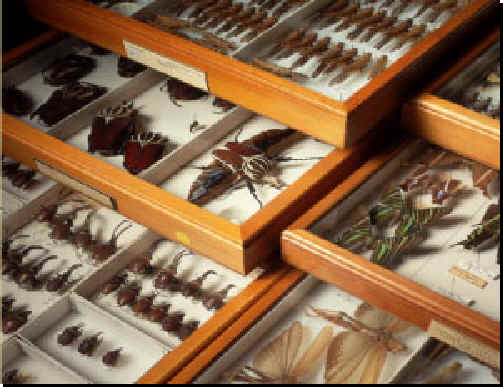|
Biodiversity
Informatics
Broadening the Database
Field and Future Directions
for Database Research
Biodiversity
| Biodiversity Informatics | Biodiversity
Keynote/Invited Talks
Industry Sessions | Biodiversity
Domain
Session
Background Material | VLDB Endowment Panel

|
Biodiversity
The
most striking feature of Earth is the existence of life, and the most
striking feature of life is its diversity. This biological diversity—or
biodiversity—provides
us with clean air, clean water, food, clothing, shelter, medicines, and
aesthetic enjoyment. Biodiversity, and the ecosystems that support it,
contribute trillions of dollars to national and global economies, directly
through industries such as agriculture, forestry, fishing, and ecotourism
and indirectly through biologically-mediated services such as plant pollination,
seed dispersal, grazing land, carbon dioxide removal, nitrogen fixation,
flood control, waste breakdown, and the biocontrol of crop pests. And
biodiversity—the species richness of habitats per se—is
perhaps the single most important factor influencing the stability and
health of ecosystems.
|
Biodiversity
Informatics
It
is not surprising that information about biodiversity forms the basis
of one of our most important knowledge domains, vital to a wide range
of scientific, educational, commercial, and government uses. Unfortunately,
most biodiversity information now exists in forms that are not easily
accessed or used. From traditional paper-based libraries to scattered
databases of varying size and physical specimens preserved in natural-history
collections throughout the world, our record of biodiversity is uncoordinated
and poorly integrated, and large parts of it are isolated from general
use. We lack the technologies needed to effectively gather, analyze, and
synthesize these data into new discoveries. As a result, this information
is not being used as effectively as it could by scientists, resource managers,
policy-makers, or other potential client communities. The good news is
that research activities are being conducted around the world that could
improve our ability to manage biodiversity information, and the emerging
field of biodiversity informatics is attempting to meet the challenges
posed by this domain.
To
leap beyond conventional data management requires a depth of understanding
of specific domains before the solutions can be generalized. Hence, researchers
should choose an application domain within which to investigate new challenging
data management requirements. Biodiversity is an ideal such domain in
which database researchers, in co-operation with biodiversity experts,
could contribute to both good computer science and significantly contribute
to improving the world for all living creatures. Such multi-disciplinary
work requires significant time and effort to understand the domain requirements
and the potential that data management could bring.
Biodiversity and biodiversity informatics were chosen as themes of VLDB
2000 to illustrate the Broadening Strategy. Biodiversity involves
a worldwide network of people, computers, and information bases that are
vastly more effective used co-operatively than separately. The Biodiversity
keynote by Dr. Ebbe Nielsen, the Biodiversity Domain Session, and the
Applications Industrial Session pose relevant challenges to the database
community.
Biodiversity
Keynote/Invited Talks
Dr.
Ebbe S. Nielsen, Director,
Australian National Insect Collection, and one of the world's leading
biodiversity scientists and an expert in the developing field of biodiversity
informatics, will give a keynote talk titled "Biodiversity
Informatics: The Challenge of Rapid Development, Large Databases and Complex
Data."
Industry
Sessions
The
VLDB2000 Industrial and Domain Sessions were selected by Industry and Domain
Session Program Chair Umesh Dayal, Hewlett-Packard Laboratories (USA). In
VLDB2000 there was a significant increase in the number of industrial sessions,
one of the strongest ever in a VLDB, plus an innovation called a Domain
Session, which focuses on the conference application theme of biodiversity.
Domain
Session on Biodiversity Informatics
Background
Information on Biodiversity and Biodiversity Informatics
Biodiversity
Informatics is a discipline at the
crossroads of biology and information technology using computers to solve
problems in the life sciences; traditionally with emphasis in the areas
of medical, genetic, and molecular biology, but increasingly being used
more broadly to cover methods for gathering, discovering, and accessing
all biological data, to serve the diverse needs of scientists, research
biologists, resource managers, decision makers, educators, and the public.
The following resources provide additional information on biodiversity
and biodiversity informatics.
VLDB
Endowment Panel and the Biodiversity Theme
Over
its fifty-year history, computer science has produced an amazingly rich and
powerful set of general-purpose tools. As general purpose tools, they are
somewhat sterile. It may now be time for computer scientists to apply these
tools in specific domains to attempt to address the Grand
Challenges of Man, arising in those domains. Computer science today is much
like mathematics at the turn of the century. Advances in mathematics paved the
way for solving major problems in physics, chemistry, astrophysics,
engineering, pharmaceuticals, etc. Computing is now in position of enabling
progress towards solutions to the Grand Challenges of Man as long as the
relevant domains are fully understood.
There will be a plenary VLDB
Endowment-sponsored panel on "Broadening the Database Field
and Future Directions for Database Research." This panel is not one of the regular refereed panels in the technical program. It will
be a forum for explaining and discussing the Broadening Strategy used in
VLDB2000, the Future Directions activity of the VLDB Endowment, and
the future manifestation of these strategies. It will be moderated by John
Mylopoulos, University of Toronto,
Canada, and VLDB Endowment President and panelists are Michael L. Brodie,
GTE; Hans-Jorge Schek, ETH-Zurich; Stefano Ceri, Politecnico Di Millano;
and Umeshwar Dayal, Hewlett-Packard Laboratories.
|